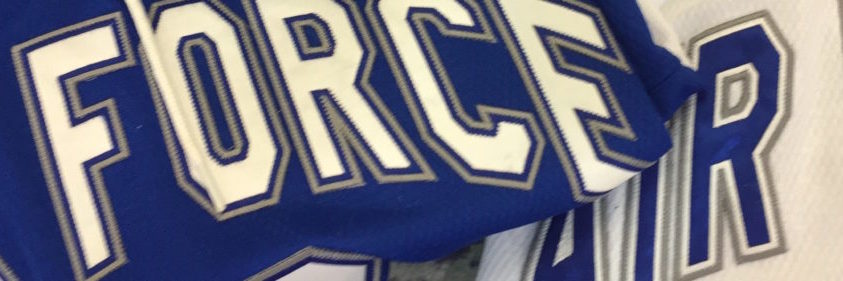Most games have been close, and a bounce here or there and perhaps they’ve stolen a few points. So at 6-6-2 with four games until the December break, is it time to press the panic button?
I would say no, and I have several reasons for my optimism, which I will outline below, after watching how the Falcons responded over the weekend against RIT. Also bear in mind the Falcons were 5-7-2 at this point two seasons ago, then lost just four more games until falling in overtime in the Atlantic Hockey semifinals. So as we used to say in the newspaper business to reassure ourselves with deadlines zeroing in on us … it’s early.
The killers
Last season Air Force had the top-ranked penalty kill in Division I, and it could go long stretches without allowing anything close to a goal when down a man. That allowed the Falcons to play a bit freer because they knew an untimely penalty likely wouldn’t do any damage.
This season has presented an interesting contrast. The Falcons allow just 2.43 goals per game (16th in D-I). But I didn’t believe my eyes when I saw in this week’s NCAA statistics that the Falcons were 41st and killing off just 78.6 percent of their penalties. I believe this has been where the injuries have impacted AFA the most – losing three excellent centers and now defenseman Dylan Abood has caught up to this special teams group.
However, it’s not as if the Falcons are taking penalties in droves, which would be one sign they’re being badly outplayed, because they’ve actually been more disciplined as the injuries have mounted.
In the first six games they were in 33 shorthanded situations (5.5 per game) and killed off 29 of them (88 percent). The Falcons went 4-1-1 in that stretch.
In the past eight games, corresponding with the beginning of AHC play, they have gone down a man just 23 times (fewer than three times per game) but they’ve allowed eight power-play goals in that span (65 percent). They’ve gone 2-5-1 in that stretch.
The timing of some of them has been bad, notably in the third period, which cost them Saturday against RIT as well as in the first game against Army. Often it’s not clearing a puck or having a clear intercepted at the blue line that’s proven costly, not the other team Harlem Globetrottering them.
The silver lining is this is fixable, and not taking many penalties is a good first step. Expect this area to improve as the lineup newcomers gain more experience and the injured veterans return.
Three up, zero down
The other part of the formula for Falcons success is pretty simple – score three goals. They’re 6-0-1 this season when that happens. They did it Friday, capped by senior Erik Baskin‘s game-winning goal, their fourth of the game.

Phil Boje
It would be one thing if the Falcons couldn’t generate shots, but they fired more total shots than RIT both nights (59-51 on Friday and 57-51 on Saturday). One difference was RIT blocked 19 of them Saturday.
When the Falcons are locked in, as they were during most of Friday’s game and Saturday’s third period, they can generate enough offense. They had a 22-9 total shots edge in the third Saturday, but only eight got through. Maybe it’s releasing a shot a split-second quicker or crashing the net harder for rebounds.
The leading trigger men were defenseman Phil Boje (14 total shots on the weekend) and Matt Koch (9) and forwards Jordan Himley (13), Matt Pulver (11) and Evan Giesler (11). And freshmen are contributing – Alex Mehnert had a multi-point game one game after Jake Levin did. Marshall Bowery scored a nice rebound goal Saturday. Zach Mirageas has been steady all season.
It feels like this is a team that can score more than the 2.36 goals per game it’s getting at the moment.
Looking up
If there is a concern, and it may be a bit early to sound this alarm, it is positioning within Atlantic Hockey. The top four teams have 13 (Army and Holy Cross) or 12 (Canisius and RIT) points. All but RIT have played more conference games than the Falcons, who have five points. Niagara and Robert Morris have 11 points, and the Purple Eagles have played one fewer game than AFA.
So there is some ground to make up and quite a few teams to go through to do it. Remember, the top three teams at the end of the regular season get a first-round bye in the league playoffs. The next four host a best-of-three series then hit the road for a best-of-three quarterfinal series. A week off at that point of the season is absolutely huge, and a more favorable quarterfinal is not far behind on the wish list. Starting the playoffs on the road by finishing eighth or lower would be on no one’s wish list.
The good news is the Falcons, in their depleted state, have wins vs. RIT and Canisius and a tie with Holy Cross. The next foe, Sacred Heart is 3-8 and 1-5 in AHC, and the Falcons close the first half at home against Niagara, so there is an opportunity to make up some ground, and perhaps quite a bit.
And the Falcons haven’t been blown out in any conference game. So it says here they’re not as far away as it appears.
Copyright First Line Editorial 2017
Follow @AFAFlightPath on Twitter for Air Force hockey updates




